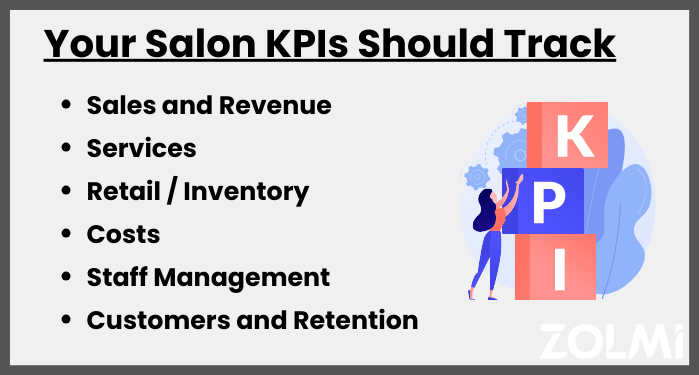How to Set KPIs for Salons? Your Complete Guide


Creating and tracking KPIs for salons is one of the most important things you can do in order to help your business succeed.
Key performance indicators for hair salons help you to understand whether or not your business is profitable and what areas you and your team should focus on in the future.
We’ll go over the basics of KPI strategies and what to measure, as well as some tools that you can use to set and monitor different target metrics for your own salon business.
KPI, or key performance indicator, is a metric that allows you to measure your salon’s progress in relation to different goals or objectives. These can be used to monitor your business over both a short term and long term period.
A KPI for a hair salon might be the average number of new customers you attract each week, for example. These targets give salon owners and staff valuable data and insights into the business and it’s growth.
A KPI tracking strategy is necessary if you want to analyze the results of your staff’s hard work, set realistic goals and priorities for the future of your business.
In a service market that’s always changing and is customer-oriented, tracking your business targets will help you to stay ahead of the competition and predict new trends more easily.
KPIs will help you to evaluate your employees more effectively and give meaningful coaching when needed. This can make a big difference in job satisfaction and staff (not to mention customer) retention.
Specific: Make everything you choose to measure as specific as possible, leaving no room for human error or misinterpretation. For example, you can create goals for the number of add-ons or additional services sold each day.
Measurable: Assign a number value or percentage to things, so that everyone can see their progress. An example of this would be a goal of increasing new clients by 10% this month.
Attainable: Make sure that it’s a reasonable goal. It’s great to push for improvement, but you don’t want to set a standard that’s so high it discourages people from trying.
Relevant: Take a look at the goals and long-term vision you have for your salon. Every KPI should be working towards helping you achieve this.
Timely: Just like having realistic goals, you’ll need to have a total time to complete them. Then, everyone will know how much time they have to achieve them.
So, how do you know which KPI’s your business should track in order to be a success? We’ve put together a list of KPI examples to help you get started.

Measuring salon revenue will help you to understand the overall financial success of your business. You should check to see if you’re hitting each monthly target, where you’re falling short each month, and how your company is doing in relation to each previous period’s report.
Total Sales - total sales in a chosen period
Salon Services Sales
Retail Sales
Progress Toward Monthly Sales Targets - total sales from month to date divided by the monthly target
Current Sales Period vs. Prior Period - difference between sales from current and previous period
Profits per Minute - showing the value of time in your salon, necessary to determine your salon pricing
Make sure to track your service data separately from your retail targets. This will make it easier to see how each employee is doing as well as how you’re going overall with your clients and how successful your salon marketing is.
Service Revenue per Square Foot
Services Delivered per Hour
Overall Sales Growth
Average Ticket - average dollar amount a client spends per visit
Average Margins - average gains on services sold
Add-ons Attachment Rate - number of add-ons sold at each appointment
These KPIs will help you assess how successful is your salon inventory management as well as help you determine whether your employees are selling enough salon retail products during visits, as well as which items are selling well.
Retail Sales vs Total Sales
Retail Items Sold per Hour
Retail Items Sold per Appointment
Retail Profit Percentage - your profit margin by product
Retail Revenue per Square Foot
Backbar Costs - costs of all professional products used
Stock Expiry Write-off - amount of obsolete salon stock
Gift Card Sales
Retail and Service Stock Turnover Rate - rate at which your salon stock is sold or used up
Monitoring your salon expenses is about more than money, it helps you to plan the future of your business. Make sure that this metric includes both of the following things:
Salon Costs per Minute - (running costs per period) / (umber of working hours) / 60
Staff Costs vs Revenue - percentage of income vs. staff expenses
It’s not enough to know how your products are selling or what your expenses are - you’ll also need to use metrics to do proper salon staff appraisals.
Service Revenue per Staff Member
Retail Revenue per Staff Member
Total Turnover per Staff Member
Clients Served per Staff Member
Client Retention Rate by Staff Member
Productivity Rate - booked hours divided by available hours - that will help you evaluate the percentage of hours available for sale. Good benchmark would be 75% to 80%
Rebooking Rate - percentage of future appointments booked within 24 hours from a previous appointment
Staff Availability - the total hours per week when they don’t have an appointment
Staff Customer Satisfaction - results of client responses to post-appointment survey
Sales vs Wages
Staff Retention and Seniority
Let’s not forget to keep an eye on are your customers: salon client retention, appointment frequency, average purchase etc. They’re the best way to know how your team is doing.
Number of Customers
Average Treatment Rate - your average number of treatments at each client’s visit
Clients Served per Day
First-time Customers
Returning Customers
New Client Retention Rate - percentage of new clients visiting and returning within 90 day. With the industry average being at 35%, we recommend you aim at least for
Repeat Client Retention Rate - with repeat clients generating 80% of salon's revenue, we recommend to set your retention target at 85% (industry average - 75%)
Cost per New Client - also called CAC, or client acquisition costs
Average Customer Spending per Visit
Pre-booking Ratio - percentage of clients pre-booking appointments
Occupancy Ratio - percentage of available appointments vs booked
Visit Frequency - how often your clients visit your salon. The salon industry average is 4.88 visits per year (per customer), we recommend you set your goal at 7 to 8 times per year
Client Satisfaction - results of customer responses to post-appointment survey (use a survey metrics such as NPS - net promoter score)
Churn Rate - the yearly percentage of customers that stop coming to your salon
When you’re choosing each KPI for your salon, make sure that you understand what you want to improve.
Be prepared to meet with your staff and explain everything in detail. Make sure they’re on board with performance metrics for salons chosen by you and why you’re using it.
Finally, every KPI that you choose should line up with people’s job descriptions, if you need them to work to achieve it.
If you want to track each KPI effectively, the easiest way to do this is to invest in the right salon scheduling software.
This is a valuable management tool that takes all of the guesswork and multiple, messy spreadsheets out of the equation. Salon software allows you to store and check your data securely, all in one place in a form of useful and easy-to-read reports.
You can also use it to send automatic post-appointment surveys and track your metrics quickly and easily, saving you the cost of both valuable time and money.
Business and marketing media is full of reasons why an effective KPI strategy can improve your salon profitability and client satisfaction rates. It’s important to know exactly what needs attention and where to focus your efforts, if you want to succeed.
By communicating with your staff and customers frequently, regularly checking your numbers and investing in the right tools, you can put your information to work for you. Using KPIs for salons is the best way to stay “a cut above” the competition (pardon the pun).
While there are many you can choose to measure your business performance, make sure you do not miss the following top 5 salon KPIs:</>
First-time Customers
Client Retention Rate
Visit Frequency
Average Ticket
Productivity Rate
Improving supply chain performance management: A systematic approach to analyzing iterative KPI accomplishment
https://www.sciencedirect.com/science/article/pii/S0167923608001693
Customer value as a key performance indicator (KPI) and a key improvement indicator (KII)
https://www.emerald.com/insight/content/doi/10.1108/1368
A comparison and evaluation of key performance indicator-based multivariate statistics process monitoring approaches
https://www.sciencedirect.com/science/article/pii/S09